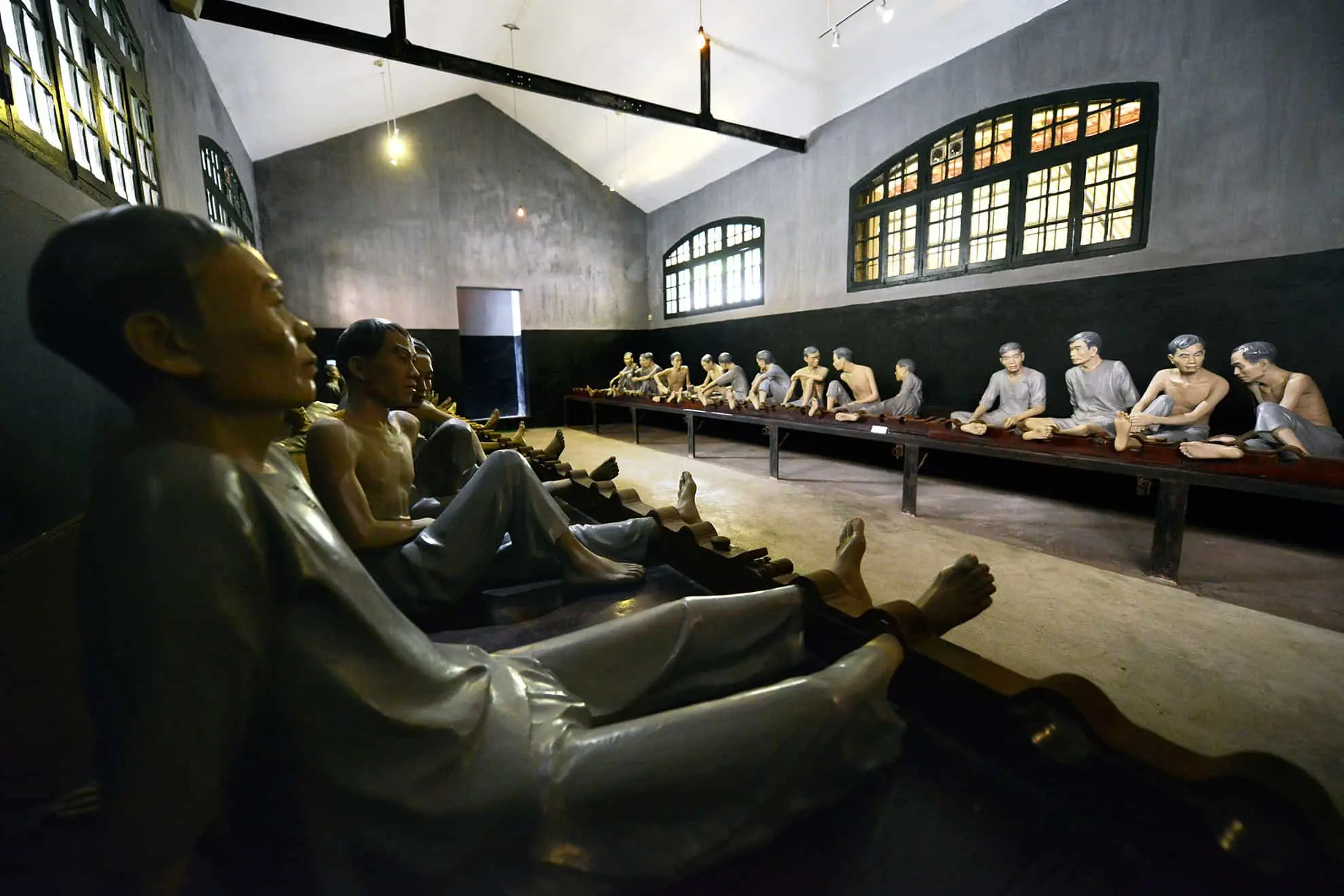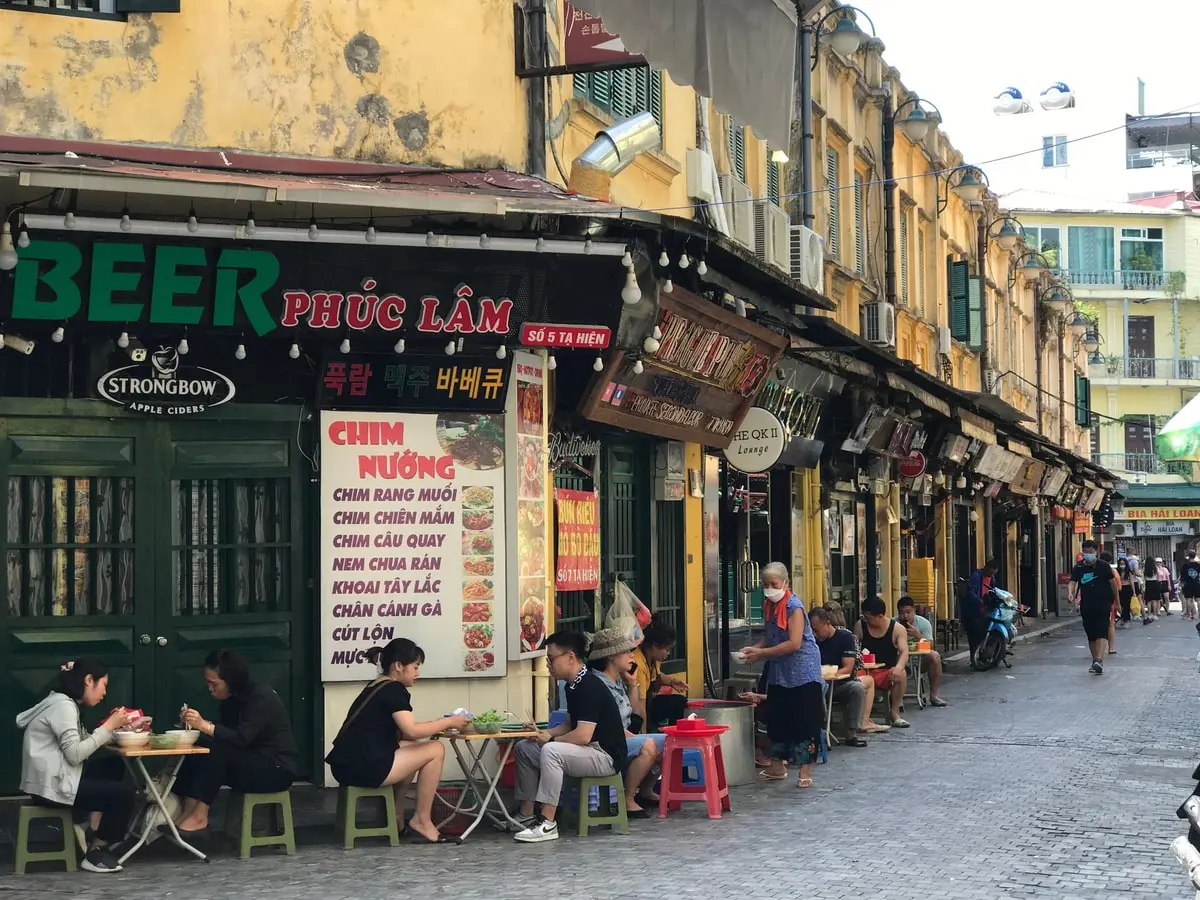Marble Mountain Vietnam, known locally as Ngu Hanh Son, stands as a prominent landmark in Da Nang, Central Vietnam. This cluster of five marble and limestone hills represents a unique convergence of nature, spirituality, and history. Located in Southeast Asia, specifically Vietnam, these mountains are more than just a geological formation; they are a significant cultural and religious site, deeply rooted in Vietnamese culture and Buddhist traditions.
EssentialVietNamtravel.com provides this guide to help you explore this fascinating destination. The Five Elements – metal, wood, water, fire, and earth – give the mountains their name and underlying philosophy. Visiting offers a chance to experience stunning natural beauty, delve into intricate caves, admire ancient pagodas, and witness breathtaking scenic views. Understanding the layout and significance of each element enhances the visitor experience.
This guide covers the essential information needed for planning your trip, from things to see and do, to navigating the main mountain, Thuy Son, and understanding the logistics involved. We will explore the caves, pagodas, viewpoints, and the nearby Non Nuoc Stone Carving Village. Prepare to discover one of Asia’s captivating natural and cultural treasures. This area attracts tourists globally, offering a blend of adventure and tranquility. It is a natural place, open to the public, holding immense religious value.
What to See and Do at the Marble Mountains (Ngu Hang Son) in Da Nang?
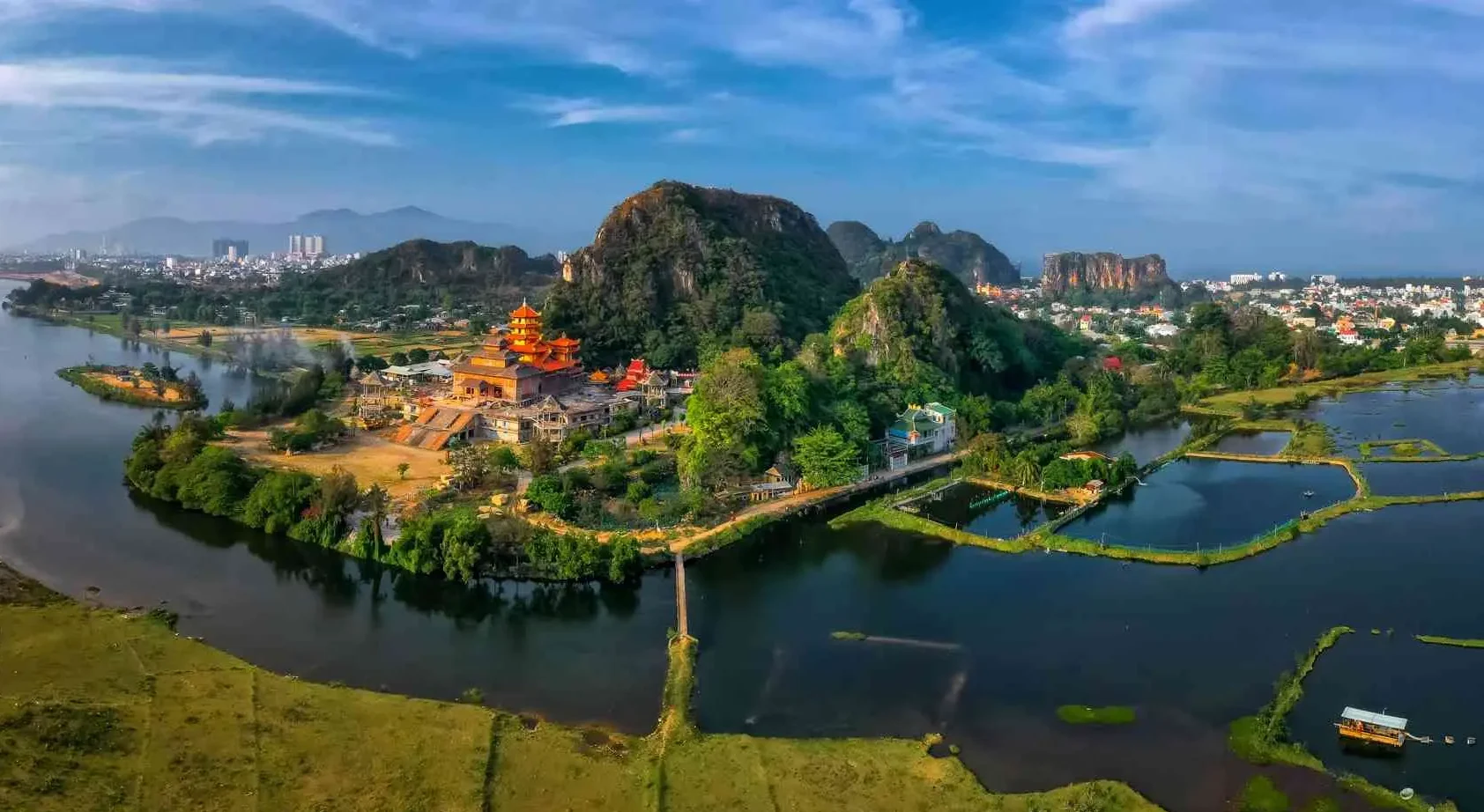
Visiting the Marble Mountains Da Nang offers a diverse range of activities and sights, making it a key Da Nang Tourist Spot. The primary activity is sightseeing, exploring the natural and man-made wonders spread across the Mountain Cluster. The site consists of five mountains: Kim Son (metal), Moc Son (wood), Hoa Son (fire), Tho Son (earth), and the most visited, Thuy Son (water). While Thuy Son is the main focus for most tourists due to its accessibility and numerous attractions, the surrounding mountains contribute to the overall landscape and significance.
Exploring involves navigating pathways, climbing stairs, and discovering hidden corners. One of the main draws is the extensive network of natural caves formed within the limestone and marble composition. These caves range from small grottoes to large, cathedral-like caverns, many housing Buddhist sanctuaries and shrines. These natural caves with shrines provide quiet spaces for reflection. Interspersed among the caves are several Buddhist pagodas, adding a layer of deep spiritual significance to the visit.
These structures, often ancient, showcase traditional Vietnamese architecture and religious art. Reaching viewpoints is another key activity, rewarding climbers with panoramic scenic views of the surrounding area, including the coastline and Da Nang city. For those less able or inclined to climb the numerous stairs, an elevator (Accessibility Feature) provides access partway up Thuy Son mountain, making the main pagodas and some viewpoints more reachable. Understanding the naming basis, the Five Elements, adds depth to the exploration, connecting the physical landscape to ancient philosophy.
Visitors can also learn about the Vietnamese history associated with the site, including its use during wartime. The Marble Mountains represent a significant Tourist Attraction and Religious Site within Vietnam tourism. EssentialVietNamtravel.com recommends allocating several hours to fully appreciate the things to do marble mountain vietnam. Remember this location is in Da Nang, Vietnam, a country in Southeast Asia, part of the larger continent of Asia. The combination of Nature, Buddhism, and Vietnamese Culture makes it a must-visit Da Nang attraction. Features Caves and Features Pagodas are prominent highlights.
Exploring Thuy Son Mountain: Pagodas, Limestone Caves, and Views
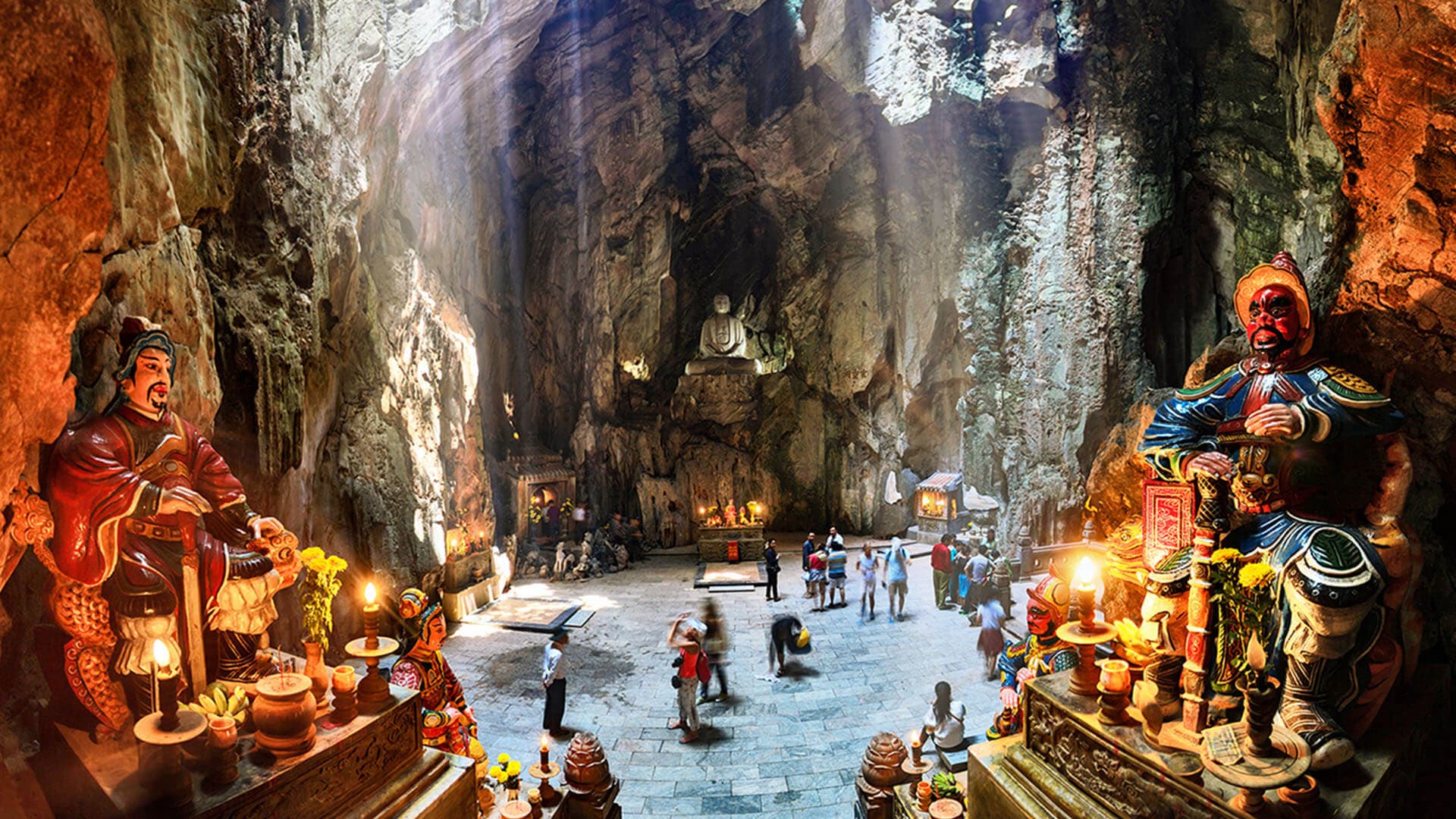
Thuy Son, representing water in the Five Elements, is the largest and most popular of the Marble Mountains Vietnam. It serves as the main hub for visitor activity due to its concentration of pagodas, limestone caves, and accessible viewpoints. EssentialVietNamtravel.com suggests starting your exploration here. Accessing Thuy Son typically involves climbing a series of stone steps, though the elevator offers an alternative for reaching the lower levels more easily. As you ascend this Vietnam mountain, pathways wind through lush vegetation, leading to various points of interest.
The mountain is a significant Religious Site, home to several important Buddhist pagodas. Linh Ung Pagoda is one of the most well-known, attracting pilgrims and tourists alike. Tam Thai Pagoda, perched higher up, offers historical significance and serene surroundings. These pagodas are active places of worship, providing insight into local Buddhism practices. Beyond the pagodas, Thuy Son is renowned for its intricate system of natural caves and grottoes. These caves vary greatly in size and character. Some are small, intimate spaces with ancient shrines, while others are vast chambers that inspire awe.
Exploring these underground formations is a highlight, revealing hidden altars and unique geological features formed over centuries within the marble and limestone composition. The climb up Thuy Son culminates in several viewpoints offering spectacular scenic views. From these vantage points, you can gaze out over the other Marble Mountains, the nearby coastline including My Khe Beach, the expanse of Da Nang city, and the Han River delta. On clear days, the Son Tra Peninsula might be visible in the distance.
These coastal viewpoints provide excellent photo opportunities and a chance to appreciate the topography of the region, contrasting the mountains with the surrounding lowland plain. Exploration requires walking and climbing, so appropriate footwear is essential. Thuy Son encapsulates the essence of Marble Mountains Da Nang: a blend of natural beauty, cultural depth, and historical layers. It Features Caves, Pagodas, and Viewpoints, making it the primary destination within the mountain cluster. Remember this mountain in vietnam is part of a larger cluster located in Vietnam.
Discovering Huyen Khong Cave and Other Grottoes
Among the many caves perforating Thuy Son, Huyen Khong Cave stands out as one of the most impressive and significant. EssentialVietNamtravel.com highly recommends dedicating time to explore this remarkable cavern. Accessing Huyen Khong Cave often involves descending a flight of stairs, leading you into a large, dramatic underground chamber. The cave’s composition is primarily limestone, sculpted by natural processes over millennia.
What makes Huyen Khong Cave particularly atmospheric are the shafts of natural light that penetrate through openings in the ceiling, illuminating the interior. Inside, a large statue of Buddha dominates the main altar, creating a serene and spiritual focal point. Smaller shrines and temples are nestled into the cave walls. This space feels sacred and ancient. Historically, Huyen Khong Cave served practical purposes beyond religion; during the Vietnam War, it was reportedly used as a secret field hospital and base by revolutionary forces, adding a layer of historical context to its natural beauty.
This wartime hideout history is a poignant reminder of Vietnam’s past. Exploring Huyen Khong involves walking on uneven ground within the underground space. Other notable grottoes on Thuy Son include Van Thong Cave (Heaven Gate Cave), which requires a tight squeeze to reach a viewpoint, offering a sense of adventure. Am Phu Cave (Hell Cave), though often accessed from the base near the entrance area rather than high on Thuy Son, depicts Buddhist interpretations of the underworld and is another major cave feature associated with the Marble Mountains complex, specifically representing the descent.
These limestone caves and natural caves with shrines are integral to the Marble Mountains experience, offering moments of discovery and reflection. Cave exploration here reveals both geological wonders and cultural artifacts. The marble in vietnam found here has been historically significant.
Finding Spiritual Serenity at the Buddhist Pagodas
The Marble Mountains Vietnam, particularly Thuy Son, are deeply spiritual places, punctuated by numerous Buddhist pagodas and shrines that invite quiet contemplation. EssentialVietNamtravel.com recognizes these as core elements of the site’s appeal. As you explore the pathways of Thuy Son, you will encounter several significant pagodas, each with its own history and architectural charm. Linh Ung Pagoda is often one of the first major pagodas visitors encounter. It features traditional Vietnamese Buddhist architecture, intricate carvings, and statues depicting various deities and figures from Buddhist lore.
The atmosphere is one of reverence, with the scent of incense often filling the air. Tam Thai Pagoda, dating back centuries, holds historical importance. Situated higher on the mountain, reaching it involves more climbing, but the reward is a tranquil setting and beautifully preserved structures. It offers a glimpse into the long history of Buddhism in this region of Central Vietnam. Smaller shrines and altars are also scattered throughout the mountain, tucked into caves or perched on ledges. These spots provide intimate spaces for prayer and reflection, reflecting the deep integration of Buddhism into Vietnamese Culture.
Visiting these pagodas requires respectful behavior. While exploring these Buddhist sites in Vietnam, remember they are active places of worship. Dressing modestly, covering shoulders and knees, is recommended. Observing rituals and showing deference to monks and worshippers enhances the experience and shows respect for the religious significance of the Marble Mountains. These pagodas contribute significantly to the site’s status as an important Religious Site, offering visitors a chance to connect with Vietnam’s spiritual heritage amidst stunning natural surroundings. The presence of these pagodas reinforces the cultural significance of this Da Nang Tourist Spot. It holds religious value for many locals and visitors.
Reaching the Summit for Panoramic Coastal Views
One of the most rewarding aspects of exploring Thuy Son at Marble Mountain Vietnam is ascending to its various viewpoints to take in the breathtaking panoramic scenic views. EssentialVietNamtravel.com encourages visitors to make the effort, as the vistas are truly memorable. The climb primarily involves navigating stone staircases, which can be steep in places. While it requires walking and some physical exertion, the paths are generally well-maintained. As you ascend, clearings and designated platforms offer stunning perspectives.
From the highest points on Thuy Son, known as Vong Giang Dai (River Watching Tower) or Vong Hai Dai (Sea Watching Tower), the landscape unfolds dramatically. You gain a clear view of the other four Marble Mountains (Kim Son, Moc Son, Hoa Son, Tho Son) rising from the coastal plain. Below, the vast expanse of Non Nuoc Beach, part of the famous My Khe Beach coastline, stretches along the turquoise waters of the East Sea. Looking inland, you can see the city of Da Nang spreading towards the Han River. On exceptionally clear days, the distant outline of the Son Tra Peninsula, home to another famous Linh Ung Pagoda, may be visible to the north.
Further south, the coastline curves towards the historic town of Hoi An Ancient Town. These coastal viewpoints provide not just beautiful photo opportunities but also a geographical context for the Marble Mountains’ location in Central Vietnam. They highlight the site’s natural beauty, juxtaposing the rugged marble hills with the flat coastal lowlands and the ocean. Reaching these summits offers a sense of accomplishment and provides a moment to appreciate the scale and beauty of this unique Vietnamese landscape. The viewpoints are a key feature that attracts tourists seeking visual exploration and stunning scenery.
Planning Your Visit to Da Nang’s Marble Mountains Attractions

Proper planning ensures a smoother and more enjoyable visit to the Marble Mountains Vietnam. EssentialVietNamtravel.com provides these practical tips for your trip preparation, covering key aspects from transportation to timing. Located conveniently between Da Nang city and Hoi An Ancient Town in Central Vietnam, the Marble Mountains are easily accessible. Understanding how to get there, the costs involved, and the best times to explore will enhance your experience at this major Tourist Attraction. First, consider transportation.
Options range from taxis and ride-sharing services like Grab, which are readily available in Da Nang, to renting a motorbike for more flexibility. Joining a guided tour is another possibility, often combining the Marble Mountains with other nearby attractions. Next, factor in the costs. There is typically a modest marble mountain vietnam entrance fee to access Thuy Son, the main mountain. An additional, separate fee applies if you choose to use the elevator for part of the ascent. Fees for Am Phu Cave might also be separate. It’s wise to carry Vietnamese Dong (VND) in cash for these fees and any potential purchases at the Non Nuoc Village.
Knowing the opening hours, usually from early morning to late afternoon, helps plan your schedule. To make the most of your visit and avoid the peak heat and crowds, consider arriving early in the morning or later in the afternoon. The best time to visit marble mountain vietnam climatically is during the dry season (roughly February to August), although visiting is possible year-round. Finally, think about what to wear and bring. Comfortable walking shoes are crucial due to the numerous stairs and uneven paths.
Lightweight clothing suitable for warm weather is generally best. However, remember to dress modestly (covering shoulders and knees) if you plan to enter the pagodas, out of respect for the religious sites. Sunscreen, a hat, and bottled water are also highly recommended. This visit planning ensures you are prepared for the Requires walking and exploration involved in experiencing this unique location in Vietnam.
How to Get There: Transportation Options
Reaching Marble Mountain Vietnam from Da Nang city center or Hoi An Ancient Town is straightforward, with several transportation options available. EssentialVietNamtravel.com outlines the most common methods. The mountains are situated approximately 9 kilometers south of Da Nang and about 20 kilometers north of Hoi An, making them an easy half-day trip from either location. Taxis or ride-sharing services like Grab are a convenient choice. You can easily book a car from your hotel or location in Da Nang or Hoi An. Agree on the fare beforehand or ensure the meter is used for taxis. For Grab, the price is fixed in the app.
This option offers comfort and direct transport. Renting a motorbike is a popular and affordable option for independent travelers. Rental shops are abundant in both Da Nang and Hoi An. This gives you the freedom to explore at your own pace and potentially visit other nearby sites. Ensure you have an appropriate driving license and are comfortable with Vietnamese traffic. The route along the coastal road is scenic and relatively easy to navigate. Follow signs for Ngu Hanh Son. Joining a tour (marble mountain vietnam tour) is another hassle-free way to visit.
Many tour operators in Da Nang and Hoi An offer half-day or full-day trips that include the Marble Mountains, often combined with Non Nuoc Village, Son Tra Peninsula, or Hoi An. This option includes transportation and often a guide, providing historical context. While less common for tourists, local buses do run along the coastal road between Da Nang and Hoi An and pass by the Marble Mountains. This is the most budget-friendly option but requires navigating the local bus system, which can be challenging without knowing Vietnamese. Understanding how to get to marble mountain da nang helps in smooth travel planning. The Location is well-signposted from the main coastal road.
Planning Your Trip to Da Nang?
Before exploring the mountains, find the best flight deals to get you there. Compare prices and book your flight to Da Nang seamlessly.
Understanding Entrance Fees and Opening Times
Knowing the entrance fees and operating hours for Marble Mountain Vietnam is essential for planning your budget and schedule. EssentialVietNamtravel.com provides the typical details, though it’s always wise to check for the most current information upon arrival as changes can occur. There is generally an entrance fee required to access Thuy Son mountain, where most of the main attractions like pagodas and caves (including Huyen Khong Cave) are located.
This marble mountain vietnam entrance fee is usually quite affordable, paid at the ticket booths near the base entrances. Keep in mind that Am Phu Cave (Hell Cave), located at the base of Thuy Son, often requires a separate entrance ticket. If you wish to use the glass elevator that ascends partway up Thuy Son, there is an additional fee for a one-way or round-trip ticket. This Elevator access can save considerable climbing effort, especially for reaching the Linh Ung Pagoda area quickly. Payment for tickets is typically required in Vietnamese Dong (VND).
It’s best to carry sufficient cash, as credit card facilities may not always be available or reliable at the ticket counters. The Marble Mountains are generally open to the public seven days a week. Standard opening hours are usually from around 7:00 AM to 5:00 PM or 5:30 PM. Visiting within these hours ensures access to all main areas, caves, and pagodas. Arriving earlier in the day often means cooler temperatures and fewer crowds. Checking the official Da Nang tourism website or asking your hotel for the latest fee structure and opening times before your visit is always a good practice. The site is open to public access during these hours.
Best Time to Visit and What to Wear
Choosing the best time to visit Marble Mountain Vietnam and dressing appropriately can significantly impact your comfort and enjoyment. EssentialVietNamtravel.com offers advice based on climate and site conditions. The climate in Da Nang, Central Vietnam, is tropical monsoon, with a distinct dry season (typically February to August) and rainy season (September to January). The dry season offers more sunny days and comfortable temperatures, making it generally the preferred time for sightseeing. However, even during the rainy season, visits are possible, often with rain showers occurring in the afternoon.
Regarding the time of day, early morning (soon after opening around 7:00 AM) or late afternoon (after 3:00 PM) is highly recommended. Visiting during these times helps you avoid the intense midday heat, especially during the summer months, and also bypasses the peak tourist crowds that often arrive mid-morning. What you wear is crucial for navigating the site comfortably and respectfully. Comfortable walking shoes with good grip are essential. You will be doing a lot of walking and climbing numerous stone steps, which can be uneven or slippery, especially after rain.
This site Requires walking. Lightweight, breathable clothing is suitable for the warm climate. However, since the Marble Mountains include important Buddhist pagodas and are considered a Religious Site, dressing modestly is important. Ensure your shoulders and knees are covered when entering pagoda grounds and sacred cave areas. Carrying a light scarf or sarong can be useful for covering up if needed. Sun protection, including a hat, sunglasses, and sunscreen, is advisable year-round. Staying hydrated is also key, so bring a bottle of water or purchase drinks available at the base. Following this guidance on the best time to visit marble mountain vietnam and appropriate attire will ensure a more pleasant exploration.
The Artistry of Non Nuoc: Vietnam’s Famous Marble Carving Village Nearby
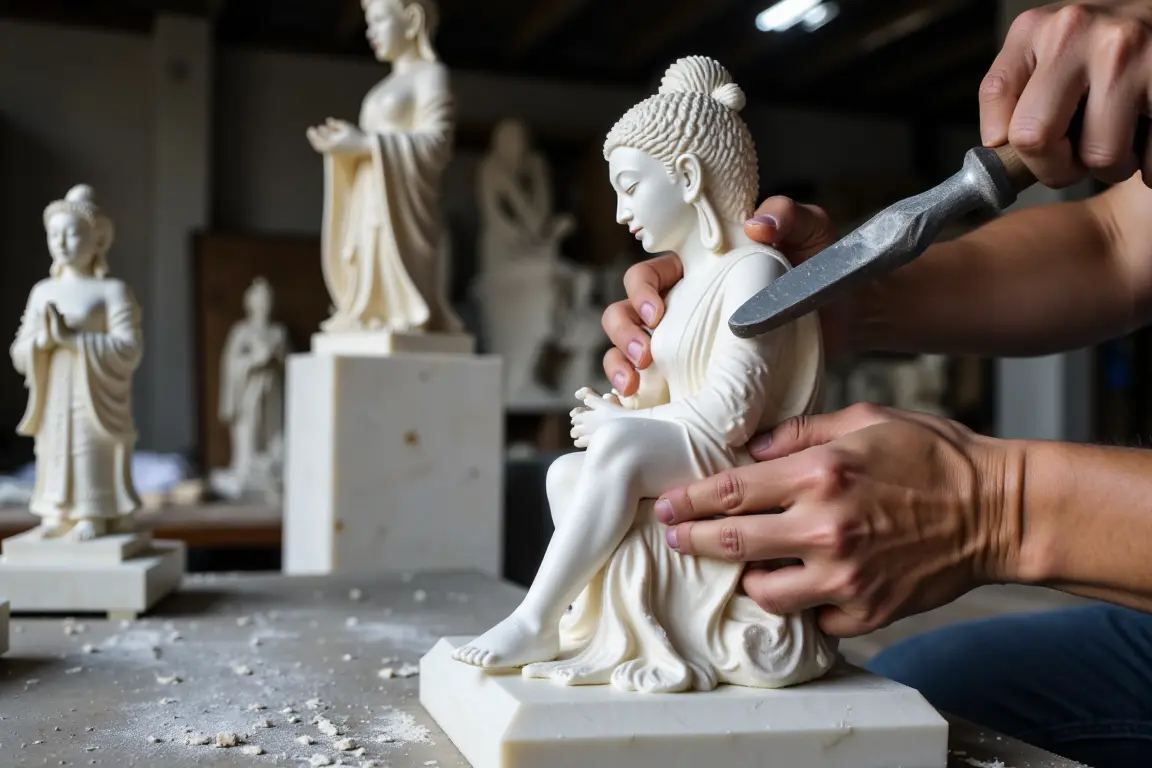
Located at the very foot of the Marble Mountains Vietnam lies Non Nuoc Stone Carving Village, an integral part of the area’s cultural landscape and history. EssentialVietNamtravel.com highlights this adjacent carving village as a worthwhile stop during your visit. This traditional handicraft village has a history spanning several centuries, intrinsically linked to the mountains themselves. Artisans here have long utilized the marble and limestone extracted (historically, though quarrying on the mountains is now restricted to protect the site) from the Marble Mountains composition to create intricate sculptures and artifacts. Visiting Non Nuoc offers a fascinating glimpse into the meticulous craft of marble carving. You can wander through numerous workshops and showrooms displaying a vast array of products.
These range from large, imposing statues of Buddha, deities, and mythical creatures to delicate jewelry, small figurines, household items like vases and bowls, and even custom-made pieces. The skill of the artisans is evident in the detailed workmanship. Observing them at work, carefully chipping, sanding, and polishing the stone, provides insight into the dedication required for this art form. The village plays a significant role in the local economy, contributing to the Economic impact of tourism in the Da Nang area.
While browsing, you’ll see pieces made not only from local marble but also from stone imported from other regions of Vietnam and beyond, reflecting the evolution of the craft. When considering purchasing marble in vietnam souvenirs, take your time to look around different shops, compare quality and prices. Bargaining is common practice in many smaller shops. Non Nuoc Village represents a living tradition of Vietnamese Culture and Handicraft villages. It complements the natural and spiritual exploration of the mountains by showcasing human artistry derived from the very stone of Ngu Hanh Son.
This activity, Marble Carving, defines the Non Nuoc Village experience, closely associated with the Marble Mountains. Understanding the connection between the mountains and the village adds another layer to your visit to this unique Da Nang attraction. You can find items showcasing ‘marble in vietnamese’ styles. The marble mountains in vietnam are inseparable from this craft tradition.
This comprehensive guide from EssentialVietNamtravel.com aims to provide you with the necessary information to fully appreciate your visit to Marble Mountain Vietnam (Ngu Hanh Son). By understanding what to see and do, how to explore Thuy Son, planning your logistics effectively, and appreciating the artistry of Non Nuoc Village, you can immerse yourself in the natural beauty, cultural significance, and historical depth of this remarkable Vietnamese landmark. Enjoy exploring the caves, pagodas, and viewpoints of this unique Mountain Cluster in Da Nang.


